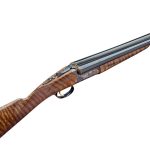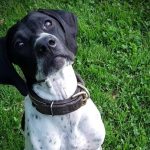Pointing Dog Pointers: Too Much, Too Soon?
By Bob and Jody Iler
Pointing dog owners love their pups and want to develop them into top notch bird dogs. They are eager to learn and try different methods of training. Sometimes, though, this can lead to problems.
One of our clients arrived at our kennel with his young German shorthair, Molly. She was about a year old, and seemed timid and confused. When we took her out to the field she just stood there, not moving, and certainly not eager to hunt. After asking her owner what he had done in the way of her puppy training, he replied, “Everything!” This included the use of the e-collar, trying to steady her to wing and shot, trying to force-break her to retrieve, teaching her to honor, and a full course in obedience (yard work). It was evident that Molly’s owner had done too much, too soon.

Keep lessons in line with pup’s age and ability.
During the first year of a bird dog puppy’s life, he can’t do anything wrong when it comes to the birds and field work. Repeat this sentence as often as it takes to instill it in your mind. Pup needs to become confident, bold, and happy – having the time of his life! Of course, some minor discipline may be needed now and then, but should always be done in a kind, light-hearted manner.
Let’s talk first about the puppy and yard work. The basic commands we teach while developing our young student are Here (Come), Whoa, and Heel. We like to see puppies very birdy and showing enthusiastic hunting ability before we start them on the yard work. Even then, when they are young, we’re not looking for perfection on these commands, but rather an understanding of what the commands mean. Again, we don’t want to do too much, too soon. The heeling does not have to be perfect and pup doesn’t need to whoa like a statue. We do, however, emphasize the come command, in a firm but positive and fun manner.
Other key pitfall areas where too much too soon can get you and pup into trouble are: steadying to wing and shot, force-breaking to retrieve, gun introduction, noisy electronic traps, and pointing birds.
Trying to steady a pup to wing and shot can lead to other issues. Later on, he may start to lie down on point, and once this happens it may be almost impossible to cure. Too much pressure and constant correction can deflate his interest in birds and perhaps turn him off of them entirely. There’s a time for everything in bird dog training, and steadying to wing and shot is “college level” work, best done after at least a season or two of successful hunting.

Some dogs are natural retrievers.
If you have a natural retriever, you’re lucky! Competing with your dog will often require retrieves to hand, which means many dogs go through what we call the “trained retrieve.” This is also college level work, not to be started until pup is enthusiastically hunting and has a season or two below his belt. Competition events may not interest you, and if your goal is primarily to have a great hunting partner, the natural retrieve should work well for you. Too much too soon in the area of retrieving can result in a dog that refuses to retrieve at all or even avoids birds completely.
Gun introduction should be done only after the pup is bird crazy and focused on chasing the birds. While pup is chasing, we start out by clapping a couple of short 2” x 4” blocks together. As we observe pup, making sure that there is no flinching, we gradually progress to louder caliber guns, beginning with the 22 blank pistol, and gradually continuing on with the 32 blank, and 410 and 20 gauge shotguns, all while pup is chasing the bird. There are many other ways of gun introduction, but this method has worked well for us over the years. Particularly when it comes to the gun, too much, too soon has ruined many a promising bird dog.
Noisy electronic traps can scare a puppy. We like to plant pigeons and quail using our dizzying method and gently setting or dropping birds into the cover. This way there is no man-made noise, just the sound of the wings as the bird flushes. Steel traps where the bird is released with your foot also work well with pups but care must be taken as they progress not to let them jump in on the traps. We call these “EZ traps” and first wrote about these traps in the January/February 2005 issue of PDJ.

Pup’s first quail at 11 weeks – keep it fun and positive.
Don’t get overly concerned with pup’s pointing in the early stages. Some pups are pointing at eight weeks, and some take longer. The wing and fish pole business just reflects a pup’s sight point and shouldn’t be overused, as what you want is a scent point. We had a lovely, bird-crazy Shorthair, Gretchen, that rushed in to flush birds for quite a few months until she finally started to point. But when she did, she pointed with intensity and staunchness for the rest of her life. If the point is there, it will come out – don’t try to force things too much. You can help by using good flying birds that pup can’t catch. Hunting on wild birds will generally staunch up your young dog as time and experience teach him caution.
But back to Molly – were we able to undo the damage that her owner had unknowingly done to her development?
We let Molly go back to being a puppy – which she really was, even though she was a full size one-year-old. We got her out in the field using very little voice and no checkcord to inhibit her. It took a lot of encouragement to get her to relax and not expect some kind of correction or command. We began to add some spooky quail, encouraging her to chase the birds. We did no shooting during this time at all. We let her have her head with no restrictions or pressure to do anything except have lots of fun in the field. We soon began to see a different dog as her natural instincts and prey drive finally kicked in.

If the point is there, it will come!
The key to successful bird dog development is simple. Keep a light hand and let the pup’s natural ability rise to the surface as you gently guide him, all the while watching for any signals from him that you are moving too fast. Trying to force pup into doing things that he’s just not ready for is a recipe for disaster.
Remember, have fun, relax the training pressure, and don’t do too much, too soon.
Pointing Dog Pointers features monthly training tips by Bob and Jody Iler, who operated Green Valley Kennels in Dubuque, Iowa, training pointing dogs for 50 years. Bob and Jody have written many articles for The Pointing Dog Journal.





